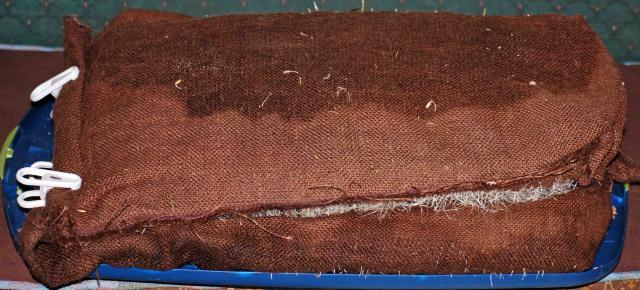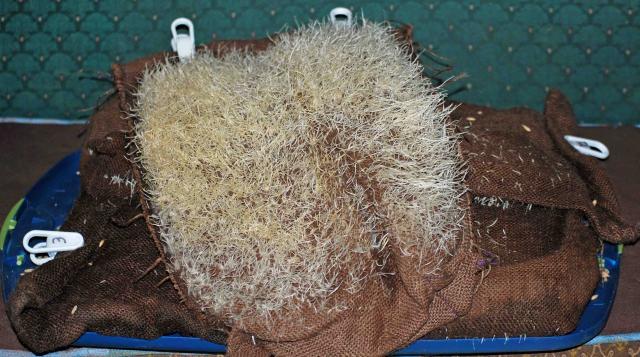Karen Thanks for the aritcles..Now to find the oats!. Good idea, buy to plantQuote:
Originally Posted by 3riverschick
Poultry Rations : Sprouted Oats
Hi Fellowlisters,
Recently, the subject of balanced poultry rations and feeding for egg
production has come up. Allied to that subject is the topic of feeding greens
to poultry , esp. in the wintertime. Sprouted oats have long been a mainstay of
poultrymen in this regard. Here is a list of articles on the subject. I have
tried to anticipate questions and cover all aspects and opinions on the subject.
Please, if you have any questions, feel free to ask.
--
"Productive Poultry husbandry: a complete text dealing with the principles
of..."
Harry Reynolds Lewis - 1913 - 536 pages - Full view
http://tinyurl.com/26cpv5c
Chapter Eleven "Poultry feeds"
Discusses the many grains and vegetables which may be utilized in creating a
proper poultry feed.
Pages 184-203
sprouted oats discussed specifically on pages 189-191:
--------
The Corning Egg Farm book: by Corning himself; being the complete ...
By Gardner Corning - 1912 - 198 pages - Full view
http://tinyurl.com/2692hj6
Pages 82 thru 84.
Intro to the subject of how to grow and feed spouted oats:
Sprouted Oats Best
At The Corning Egg Farm we are strong believers in Sprouted Oats as a green
food, and we now maintain a cement Cellar, with good drainage, which is used for
nothing else. The method of sprouting oats is really very simple, and does not
require the arduous labor which one would imagine from numerous articles written
on the subject.
-------------
The beginner in poultry: the zest and the profit in poultry growing
By Carolyn Syron Valentine
1912 - 450 pages - Full viewÂ
http://tinyurl.com/2cqwuqt
See ages 75 thru 102 for a discussion on juicy feeds and sprouted oats for
poultry.
Page 92 :"Some have assured me that barley is even better, as it tillers more
abundantly; i.e. each seed throws out more stalks, when it lies long enough to
get a real start. The New Jersey Station, after experimenting with sprouted
oats, wheat, and buckwheat, announced that in every case oats produced most
pounds and made most gain."
-----------
Poultry keeping: an elementary treatise dealing with the ...
Harry Reynolds Lewis - 1915 - 365 pages - Full view
http://tinyurl.com/2dszyjc
Page 256:
"Fig. 142.â"Sprouted oats form one of the best green feeds for poultry. They
make the best growth when sprouted at a depth of one inch, as shown in tray No.
1. When sprouted deeper they mold and do not make as many sprouts."
-----------
ad for growing stand for spouted oats from 1914 "The Poultry Item " magazine
Volume 13 page 33 :
SPROUTED OATS;
GOOD AS GRASSHOPPERS FOR GROWING CHICKS
Do you want fully developed fine birds for the shows? Then Feed the Sprouted
Oats.
Do you want quickly grown heavy early roasters? Then Feed the Sprouted Oats.
Do you want quickly matured pullets for winter laying? Then Feed the Sprouted
Oats.
Do you want an abundance of EGGS at all times? Then Feed the Sprouted Oats.
Do you want a cheap feed that is partly predigested, highly vitalizing, very
stimulating? Then Feed the Sprouted Oats.
Do you want an abundant supply of the crisp, snappy, succulent Sprouted Oats?
Then Get a
DOUBLE QUICK GRAIN SPROUTER
Double walled, heat retaining, automatic moisture producing, scientifically
constructed for sprouting any kind of grain with little or no muss or trouble In
an incredibly short time.
Sizes from a few hens to 500. Full information free. CLOSE-TO-NATURE CO., 42
Front St., Colfax, Iowa.
===============
Poultry feeds and feeding
Harry M. Lamon, Alfred R. Lee - 1922 - 247 pages - Full view
http://tinyurl.com/2ewsf3v
Pages 126 thru 127 .
Quote from beginning of section:
"Sprouted Oats. Sprouted oats make a good green feed where other kinds of green
feed are not readily secured as oats can be obtained and sprouted at any season
of the year. Fowls greatly relish oats so treated and will readily eat about one
square inch of sprouted oats' surface daily. Such oats may be fed at any time
after the sprouts are well started, the usual practice being to feed them when
the sprouts are from 1/2 to 1 1/2 inches long. It takes 5 to 7 days to sprout
oats to this length, the number of days depending largely on the temperature of
the place where the oats are sprouted."
------------
California poultry practice: being plain hints for beginners in
Mrs. Susan Swaysgood - 1914 - 157 pages - Full view
http://tinyurl.com/2e3r4hq
excerpt from feeding guidelines, Page 57 :
"If labor is not considered, there is not anything on this green earth that pays
better in eggs than sprouted oats. But it is a chore to furnish a big flock of
hens with enough sprouted oats to count. I have been feeding sprouted oats for
over ten years, so know what I am saying, but as stated, it is a big chore. Oats
to a hen is what oats is to a horse. It is life and vitality.
All horses that are to be depended upon in times of stress are fed on oats,
which gives strength and fleetness to the race horse and they will give strength
and endurance to your hens to keep on laying all the year around.
Two feeds a day of sprouted oats will give you eggs in winter, when nothing else
will. I am speaking now in general, but I am going to tell you how to feed each
breed or rather each class of poultry separately.
There are a great many mistakes made by feeding all alike. It does not pay,
because their needs are not all alike."
------
Poultry houses and fixtures: How to lay out poultry plants ...
Reliable Poultry Journal Publishing Company - 1919 - 110 pages - Full view
http://tinyurl.com/2bkpnrh
How to sprout oats and what equipment to use, illust. and w/ tabke. :
pages 102 thru 103
--------------
Why poultry pays and how to make it pay
Frank L. Platt - 1922 - 124 pages - Full view
http://tinyurl.com/29sxzbp
Beginning excerpt from pages 48 thru 49 :
"Sprouted oats. While one would think that everybody knew all about sprouted
oats, yet it is remarkable how many who have kept poultry for years know
absolutely nothing of this valuable yet very inexpensive green food. Many have
asked me for information. Most all those who have heard of sprouted oats seem to
think they are grown in the ground and nothing but the green tops are fed.
Sprouted oats are nothing but dry, every-day seed oats, soaked in water and kept
watered for some days until the oats sprout. No ground is used whatsoever. And
you feed tops, roots and all."
---------
What & how to feed poultry
Dwight Edward Hale - 1915 - 75 pages - Full view
http://tinyurl.com/2f3utyd
Page 52
short article with plans for the city breeder and larger country breeder.
SPROUTED OATS SOLVE THE PROBLEM.
In reference to the value of sprouted oats, Mr. Harris says: "For the fancier
that live on farms it is no effort to secure green stuff for their flock, but
when it comes to the city fancier, there is a great deal to contend with. I
believe all will agree that hens do not have as satisfactory laying records
where they do not obtain an abundance of green food. If the city-lot fancier
expects the results his fowls should bring, he must try in some way to overcome
this trouble. A sprouting box is, I think, the best and probably the cheapest
way to supply green food."
------------
Poultry Secrets - Gathered, Tested and now Disclosed
Michael K. Boyer ( Poultry Editor , Farm Journal )
- 1909 - 56 pages - Full view
Michael K. Boyer - 1909 - 56 pages - Full view
http://tinyurl.com/2byxxzt
Pages 24 thru 25 .
Beginning excerpt from the article :
"The Secret of Feed at 15 Cents per Bushel
The value of green food for poultry, both as an egg food and a ration for
maintaining a healthful condition, has been known for years, but of late a
method for producing sprouted oats feed has been practiced by a few knowing
poultrymen who have derived considerable profit from the idea. I give the
methods of two men, Mr. J. B. Upson and Mr. Keyser. I cannot emphasize too
strongly the great importance of a thorough understanding of the sprouted oats
method. These experiences are based on facts, not theories: "
In fact, this whole book is a fascinating little treatise. Looks like a lot of
pithy stuff here written in easily readable format.
-------------------
Many thanks to Carrie of Harmony Oaks for the info for this addenda:
Oats used to feed horses goats, etc. been treated with agermicide, - sprayed
with a product to prevent germination. This took numerous phone calls and
pressure from my feed dealer to obtain this information. - although that
they had not been labelled as such BTW- the feed was sold under the Farmer's Best
label. When they were asked to sprout, they molded instead.
ordered some oats to "seed" a pasture. They worked fine,and they were
comparibly priced . (Karen: Seed oats not easily available this time of year. I asked
at my local Agway store. They said to see a local farmer who grew seed oats, like
a dairy farm. To offer them $10.00 a bushel if they had extra. Said that price would
be enough above the price the farmer paid to seal the deal.)
Happy Holidays,
Best Regards,
Karen Tewart
Waterford French Marans
I'm just going by what it says in the articles in above post and some other reading that I did and all that I read says 1 square inch per chicken is all that should be fed. My goal is to do what is best for the chickens and save money but not compromise one for the other. Good health comes from a balanced diet. You can say they know what they need but leave them with all they can eat (insert your chickens favorite food here) and stuff that is good for them and provides a balanced diet and see what they will eat every day. I know mine would eat meal worms all day every day but it would not be good for them.
Just my opinion but to much fodder does not leave room for the rest of a balanced diet.
Fodder... not as a whole food .Makes sense.
Still 1 " per day seems like a treat not a portion of their diet.
Not sayng it doesnt say that ...just doesnt seem enough to save any money on feed.




 We have two daughters having babies next month so have been showering unborn grandbabies. Lots of cooking and planning on my brain. Not fodder lol
We have two daughters having babies next month so have been showering unborn grandbabies. Lots of cooking and planning on my brain. Not fodder lol This time I am using the newer grain, excited to see how it does. Cynthia, have you fed yours yet? Do they like it? Mine were eating snow this morning, like food, it was so weird. Chowing down on it, I do not remember seeing them do that last year.
This time I am using the newer grain, excited to see how it does. Cynthia, have you fed yours yet? Do they like it? Mine were eating snow this morning, like food, it was so weird. Chowing down on it, I do not remember seeing them do that last year.



